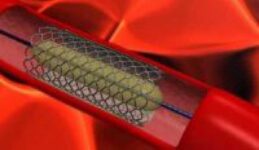Original title: Randomized Comparison of Clinical Outcomes between Intravascular Ultrasound and Angiography-Guided Drug-Eluting Stent Implantation for Long Coronary Artery Stenosis. Reference: Jung-Sun Kim et al. J Am Coll Cardiol Intv 2013. Article in press. Treating long lesions is difficult and the chance of instant thrombosis may be higher in these lesions. Coronary intravascular ultrasound (IVUS) can help in…
In diabetic patients, Everolimus eluting stents could perform better than Paclitaxel eluting stents
Original title: Safety and Efficacy of Everolimus-Eluting Stents Versus Paclitaxel-Eluting Stents in a Diabetic Population Reference: Ana Laynez et, al. Catheterization and Cardiovascular Intervention 81:759-765 (2013) Everolimus eluting stents have already been compared with paclitaxel eluting stents in the general population, and they have proved to perform best, especially as regards revascularization and in-stent thrombosis. However, these data…
Incomplete revascularization: no longer a binary variable
Original title: Residual SYNTAX score after PCI for triple vessel coronary artery disease: quantifying the adverse effect of incomplete revascularisation. Reference: Christopher J. Malkin et al. EuroIntervention 2013;8:1286-1295. In the angioplasty branch of the SYNTAX study, complete revascularization was reached in 56.7% of the population. On the other hand, in the real world, around 40% of patients that…
Bioresorbable stents produce more occlusion of the small side branches
Original title: Incidence and Short-Term Clinical Outcomes of Small Side Branch Occlusion Alter Implantation of an Everolimus-Eluting Bioresorbable Vascular Scaffold Reference: Takashi Muramatsu et al. J Am Coll Cardiol Intv 2013;6:247–57. Small Side Branch Occlusion (SBO) during coronary angioplasty has been associated with periprocedural infarction. Among the factors that cause SBO are carina displacement, plaque displacement and artery…
Cangrelor: more effective than clopidogrel without increasing bleeding
Original title: Effect of Platelet Inhibition with Cangrelor during PCI on Ischemic Events. CHAMPION PHOENIX. Reference: Deepak L. Bhatt et al. N Engl J Med 2013. DOI: 10.1056/NEJMoa1300815. Despite advances in adjuvant therapy thrombotic complications remain a problem during coronary angioplasty. So far, up to the present, there was only P2Y
Women have a higher mortality rate in ST-segment elevation acute myocardial infarction
Original title: Is the difference in outcome between men and women treated by primary percutaneous coronary intervention age dependent?: Gender difference in STMI stratified on age Reference: Amber M Otten et, al.European Heart Journal Acute Cardiovascular Care January 31:1-8 Numerous publications have shown that women have worse outcomes than men in chronic ischemic heart disease but their evolution…
Revascularization could improve areas traditionally considered necrotic
Original title: Prevalence of Regional Myocardial Thinning and Relationship With Myocardial Scarring in Patients With Coronary Artery Disease. Reference: Dipan J. Shah et al. JAMA. 2013;309(9):909-918 Regional left ventricular (LV) wall thinning is believed to represent chronic myocardial infarction. In fact, the most recent guidelines, both European and American, have concluded that “Images that show regional myocardial thinning…
Complete revascularization in one procedure is more cost effective and as safe as in stages.
Original title: Staged Versus One-time Complete Revascularization With Percutaneous Coronary Intervention for Multivessel Coronary Artery Disease Patients Without ST-Elevation Myocardial Infarction. Reference: Edward L. Hannan et al. Circ Cardiovasc Interv 2013;6;12-20. There is evidence that in patients with multi-vessel disease affected by an acute coronary syndrome (ACS) with ST segment elevation, only the cause lesion should be treated…
Coronary angioplasty reduces the risk of spontaneous myocardial infarction in chronic stable patients.
Original title: Percutaneous Coronary Intervention Versus Optimal Medical Therapy for Prevention of Spontaneous Myocardial Infarction in Subjects With Stable Ischemic Heart Disease. Reference: Sripal Bangalore et al. Circulation. 2013;127:769-781 In the context of coronary angioplasty complications may arise, such as a periprocedural infarction. However, this event does not have the same clinical consequences compared to a spontaneous infarction. …
A worse prognosis for incomplete revascularization in both angioplasty and surgery.
Original title: The Negative Impact of Incomplete Angiographic Revascularization on Clinical Outcomes and Its Association With Total Occlusions. The SYNTAX (Synergy Between Percutaneous Coronary Intervention with Taxus and Cardiac Surgery) Trial. Reference: Vasim Farooq et al. J Am Coll Cardiol 2013;61:282–94 In patients with complex coronary artery disease who underwent coronary artery bypass surgery, (CABG), or percutaneous transluminal…
It takes more patience to implant stents.
Original title: Duration of Balloon Inflation for Optimal Stent Deployment: Five Seconds Is Not Enough. Reference: Thomas Hovasse et al. Catheterization and Cardiovascular Interventions 81:446–453 (2013). Adequate stent expansion and apposition to the vessel wall is essential to optimize the results of percutaneous transluminal coronary angioplasty (PTCA). If the above is not adequate, it increases the risk of…










